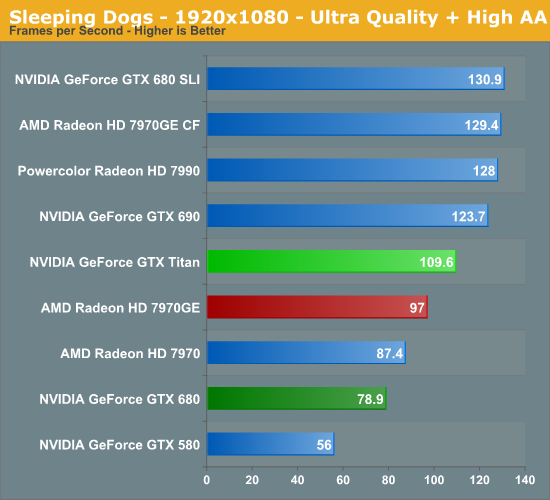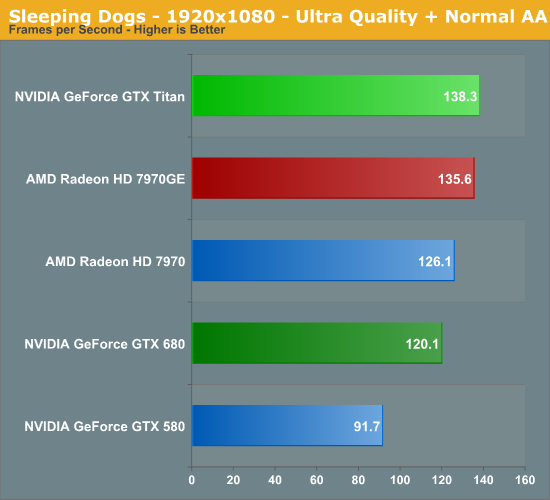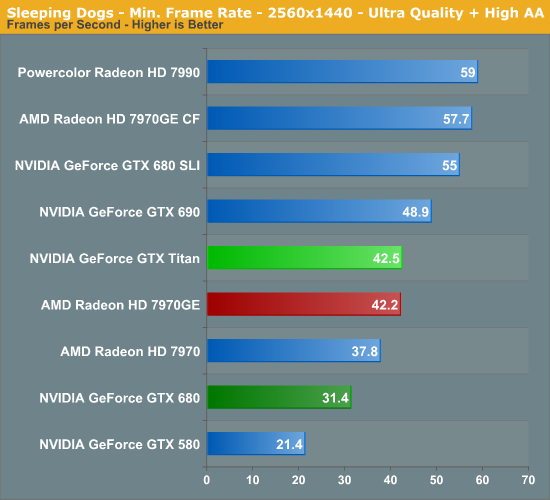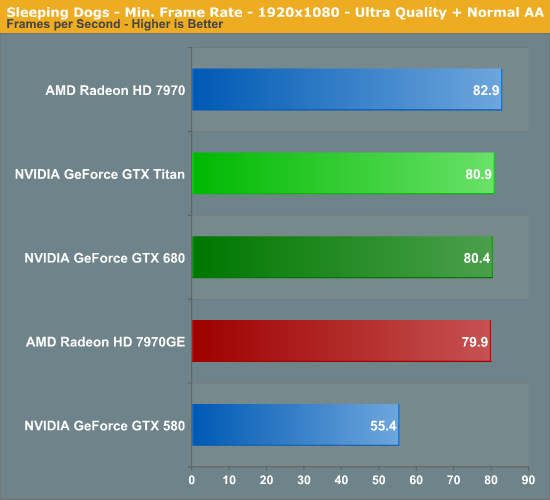NVIDIA’s GeForce GTX Titan Review, Part 2: Titan's Performance Unveiled
by Ryan Smith & Rahul Garg on February 21, 2013 9:00 AM ESTSleeping Dogs
Another Square Enix game, Sleeping Dogs is one of the few open world games to be released with any kind of benchmark, giving us a unique opportunity to benchmark an open world game. Like most console ports, Sleeping Dogs’ base assets are not extremely demanding, but it makes up for it with its interesting anti-aliasing implementation, a mix of FXAA and SSAA that at its highest settings does an impeccable job of removing jaggies. However by effectively rendering the game world multiple times over, it can also require a very powerful video card to drive these high AA modes.




Sleeping Dogs is another game that AMD cards have done rather well at, leaving the GTX 680 quite a way behind. The sheer increase in functional units for Titan means it has no problem vaulting back to the top of the list of single GPU cards, but it also means it’s crossing a sizable gap.
In the end, at 2560 at the High (second-highest) AA settings, Titan is just shy of 50% faster than the GTX 680, but a weaker 17% ahead of the 7970GE. As we drop in resolution/AA, so does Titan’s lead, as the game shifts to being CPU limited.
Notably, no single card is really good enough here for 2560 with Extreme AA, with even Titan only hitting 35fps. This is one of the only games where even with a single monitor there’s real potential for a second Titan card in SLI.
Meanwhile the gap between Titan and our dual-GPU cards is roughly as expected. The GTX 690 takes a smaller lead at 18%, while the 7990 is some 42% ahead.
Due to its built-in benchmark, Sleeping Dogs is also another title that is a good candidate for repeatable and consistent minimum framerate testing.




While on average Titan is faster than the 7970GE, the minimum framerates put Titan in a rough spot. At 2560 with high AA Titan is effectively tied with the 7970GE, and with extreme AA it actually falls behind. It’s not readily apparent why this is, whether it’s some kind of general SSAA bottleneck or if there’s something else going on. But it’s a reminder that at its very worst, Titan can only match the 7970GE.










337 Comments
View All Comments
CeriseCogburn - Tuesday, February 26, 2013 - link
Yes, and this is the core situation the radical chizow and others like him have chosen to completely ignore.Ivy is 22nm and only 14nm now appears to be possible as approx. 30 atoms are channel widths, with electromigration/plasma leakage hits a critical stage.
So the slowdown has already occurred, Moore's law is broken (decelleration has been occurring for a long time) , and the reality is near present with the "largest possible" die at Titan's node.
The number of atoms across in the "electric wire channel" and insulator sides width is down to countable on fingers and toes and it appears there's nearly no place to go.
That's why we keep hearing about quantum computing dreams, and why shrinkage steps have been less beneficial toward this wall.
So, expect the crybabies to be taking up a few notches more into an ever higher pitch the next couple of releases. It's coming, or rather it's here.
vanwazltoff - Friday, February 22, 2013 - link
the 690, 680 and 7970 have had almost a year to brew and improve with driver updates, i suspect that after a few drivers and an overclock titan will creep up on a 690 and will probably see a price deduction after a few months. dont clock out yet, just think what this could mean for 700 and 800 series cards, its obvious nvidia can deliverinitialised - Friday, February 22, 2013 - link
When are you guys going to start posting 4K performance for high end graphics?iceman-sven - Friday, February 22, 2013 - link
I am also wondering. Anandtech need to buy the Sharp PN-K321 fast. I will upgrade from my 2560x1600 to 4k in the next 12 months.I hope Anandtech does a rerun of some benchmarks with 4k and Titan SLI configurations. I am planning to buy 2 Titan for this.
Ryan Smith - Monday, February 25, 2013 - link
When someone releases a suitable desktop monitor and we can acquire it on a long-term basis. Something like Sharp's 32-incher is the right resolution, but it really pushes the boundary for what can be called a "desktop" monitor.ElminsterTCOM - Friday, February 22, 2013 - link
I was wondering if you could pop this card into a Mac Pro and let us know if it is compatible? This would be a great card for 3D modeling!Saxie81 - Friday, February 22, 2013 - link
I'm wondering why the other websites that give reviews, benchmarks etc, have missed the mark with this card. Everywhere I look, they are posting nothing but game benchmarks, this is why I keep coming to Anandtech. This clearly is meant for more than that. I'm looking @ it for gaming and 3d rendering. I would have loved to have seen maybe Rendering times on a simple image in Blender etc, but the compute benchmarks gives a pretty good indication of what the Titan is capable of. Great article as always, Ryan, and welcome Rahul!Zoeff - Friday, February 22, 2013 - link
Looking at the Crysis 1080p at highest settings benchmark. I guess they're the wrong way around? :)Ryan Smith - Monday, February 25, 2013 - link
Do'h. Fixed.realneil - Friday, February 22, 2013 - link
Seems like whenever `anyone` releases the ~newest/best~ video card, they always price it at a grand. So this isn't surprising to me at all. How much were the Matrix cards from ASUS when they were new?I just can't see spending that much for it though. A pair of 680s or 7970s would get the job done for me.